Astrophysicists found the “clumpiness” of Universe’s dark matter to be 0.76, a figure conflicting with the Cosmic Microwave Background value of 0.83, indicating possible errors or an incomplete cosmological model. The research used the Hyper Suprime-Cam Subaru Strategic Program data and will further investigate this compelling discrepancy.
An international team of astrophysicists and cosmologists at various institutes including NAOJ and the Kavli Institute for the Physics and Mathematics of the Universe have submitted a set of five papers, measuring the value for the “clumpiness” of the Universe’s dark matter, known to cosmologists as S8. The reported value is 0.76, which aligns with values that other gravitational lensing surveys have found by looking at the relatively recent Universe — but it does not align with the value of 0.83 derived from the Cosmic Microwave Background, which dates back to when the Universe was about 380,000 years old. The gap between these two values is small, but it doesn’t appear to be accidental. The possibilities are that there’s some as-yet unrecognized error or mistake in one of these two measurements or the standard cosmological model is incomplete in some interesting way.
The standard model of our Universe is defined by only a handful of numbers: the expansion rate of the Universe, a measure of how clumpy the dark matter is (S8), the relative contributions of the constituents of the Universe (matter, dark matter, and dark energy), the overall density of the Universe, and a technical quantity describing how the clumpiness of the Universe on large scales relates to that on small scales. Cosmologists are eager to test this model by constraining these numbers in various ways, such as by observing the fluctuations in the Cosmic Microwave Background, modeling the expansion history of the Universe, or measuring the clumpiness of the Universe in the relatively recent past.
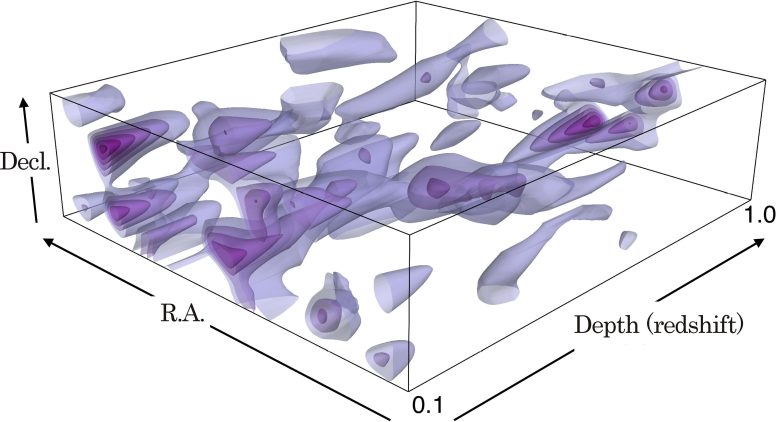
Figure 2: An example of a 3D distribution of dark matter derived from HSC-SSP. This map is obtained by using the first year’s data, but the present study examined an area on the sky about three times larger than that. Credit: University of Tokyo/NAOJ
A team led by astronomers from Kavli IPMU, the University of Tokyo, Nagoya University, Princeton University, and the astronomical communities of Japan and Taiwan, spent the past year teasing out the secrets of the most elusive material, dark matter, using sophisticated computer simulations and data from the first three years of the Hyper Suprime-Cam Subaru Strategic Program (HSC-SSP). The observation program used one of the most powerful astronomical cameras in the world, Hyper Suprime-Cam (HSC) mounted on the Subaru Telescope. The HSC-SSP data that the research team used covers about 420 square degrees of the sky, about the equivalent of 2000 full moons.
Clumps of dark matter distort the light of distant galaxies through weak gravitational lensing, a phenomenon predicted by Einstein’s General Theory of Relativity. This distortion is a really small effect; the shape of a single galaxy is distorted by an imperceptible amount. But the team measured the distortion with quite high precision by combining the measurements for 25 million faint galaxies that are billions of light-years away. Then, the team measured the clumpiness of the Universe today (Figure 3).
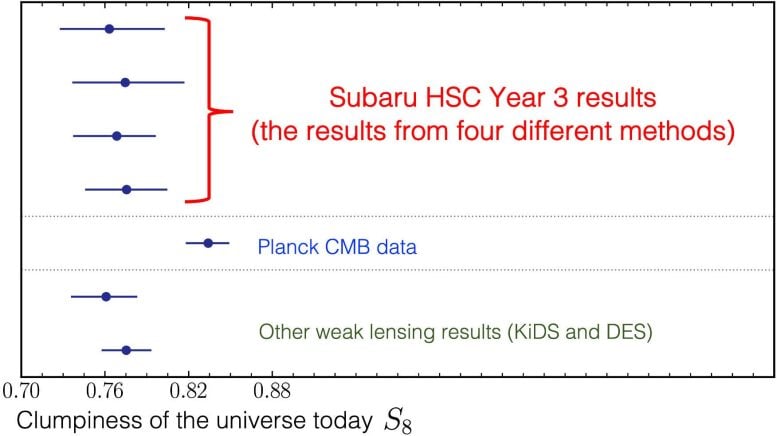
Figure3: The measurement results of S8 parameter from HSC-SSP Year 3 data. The chart shows the results from four different methods, which used different parts of the HSC-SSP Year 3 data or combined the HSC-SSP Year 3 data with other data. For comparison, “Planck CMB” shows the measurement result for S8 from the cosmic microwave background data from the Planck satellite. “Other weak lensing results” shows the results from similar weak lensing measurements based on the Dark Energy Survey (DES) and Kilo-Degree Survey (KiDS) data. Credit: Kavli IPMU
The discrepancy between the S8 values of HSC-SSP and the Planck satellite is very subtle. The team thinks that the measurement was done correctly and carefully. And the statistics show that there’s only a one in 20 probability that the difference is just due to chance, which is compelling but not completely definitive. The team will further pursue this compelling inconsistency using the full HSC-SSP data set and refined methods. The team might discover something new about the Universe, so please stay tuned.
For more on this research, see Measuring Dark Matter With Hyper Suprime-Cam Reveals Discrepancy.
References:
“Hyper Suprime-Cam Year 3 Results: Cosmology from Galaxy Clustering and Weak Lensing with HSC and SDSS using the Emulator Based Halo Model” by Hironao Miyatake, Sunao Sugiyama, Masahiro Takada, Takahiro Nishimichi, Xiangchong Li, Masato Shirasaki, Surhud More, Yosuke Kobayashi, Atsushi J. Nishizawa, Markus M. Rau, Tianqing Zhang, Ryuichi Takahashi, Roohi Dalal, Rachel Mandelbaum, Michael A. Strauss, Takashi Hamana, Masamune Oguri, Ken Osato, Wentao Luo, Arun Kannawadi, Bau-Ching Hsieh, Robert Armstrong, Yutaka Komiyama, Robert H. Lupton, Nate B. Lust, Lauren A. MacArthur, Satoshi Miyazaki, Hitoshi Murayama, Yuki Okura, Paul A. Price, Tomomi Sunayama, Philip J. Tait, Masayuki Tanaka and Shiang-Yu Wang, 3 April 2023, Astrophysics > Cosmology and Nongalactic Astrophysics.
arXiv:2304.00704
“Hyper Suprime-Cam Year 3 Results: Measurements of Clustering of SDSS-BOSS Galaxies, Galaxy-Galaxy Lensing and Cosmic Shear” by Surhud More, Sunao Sugiyama, Hironao Miyatake, Markus Michael Rau, Masato Shirasaki, Xiangchong Li, Atsushi J. Nishizawa, Ken Osato, Tianqing Zhang, Masahiro Takada, Takashi Hamana, Ryuichi Takahashi, Roohi Dalal, Rachel Mandelbaum, Michael A. Strauss, Yosuke Kobayashi, Takahiro Nishimichi, Masamune Oguri, Arun Kannawadi, Robert Armstrong, Yutaka Komiyama, Robert H. Lupton, Nate B. Lust, Satoshi Miyazaki, Hitoshi Murayama, Yuki Okura, Paul A. Price, Philip J. Tait, Masayuki Tanaka and Shiang-Yu Wang, 3 April 2023, Astrophysics > Cosmology and Nongalactic Astrophysics.
arXiv:2304.00703
“Hyper Suprime-Cam Year 3 Results: Cosmology from Galaxy Clustering and Weak Lensing with HSC and SDSS using the Minimal Bias Model” by Sunao Sugiyama, Hironao Miyatake, Surhud More, Xiangchong Li, Masato Shirasaki, Masahiro Takada, Yosuke Kobayashi, Ryuichi Takahashi, Takahiro Nishimichi, Atsushi J. Nishizawa, Markus M. Rau, Tianqing Zhang, Roohi Dalal, Rachel Mandelbaum, Michael A. Strauss, Takashi Hamana, Masamune Oguri, Ken Osato, Arun Kannawadi, Robert Armstrong, Yutaka Komiyama, Robert H. Lupton, Nate B. Lust, Satoshi Miyazaki, Hitoshi Murayama, Yuki Okura, Paul A. Price, Philip J. Tait, Masayuki Tanaka and Shiang-Yu Wang, 3 April 2023, Astrophysics > Cosmology and Nongalactic Astrophysics.
arXiv:2304.00705
“Hyper Suprime-Cam Year 3 Results: Cosmology from Cosmic Shear Power Spectra” by Roohi Dalal, Xiangchong Li, Andrina Nicola, Joe Zuntz, Michael A. Strauss, Sunao Sugiyama, Tianqing Zhang, Markus M. Rau, Rachel Mandelbaum, Masahiro Takada, Surhud More, Hironao Miyatake, Arun Kannawadi, Masato Shirasaki, Takanori Taniguchi, Ryuichi Takahashi, Ken Osato, Takashi Hamana, Masamune Oguri, Atsushi J. Nishizawa, Andrés A. Plazas Malagón, Tomomi Sunayama, David Alonso, Anže Slosar, Robert Armstrong, James Bosch, Yutaka Komiyama, Robert H. Lupton, Nate B. Lust, Lauren A. MacArthur, Satoshi Miyazaki, Hitoshi Murayama, Takahiro Nishimichi, Yuki Okura, Paul A. Price, Philip J. Tait, Masayuki Tanaka and Shiang-Yu Wang, 3 April 2023, Astrophysics > Cosmology and Nongalactic Astrophysics.
arXiv:2304.00701
“Hyper Suprime-Cam Year 3 Results: Cosmology from Cosmic Shear Two-point Correlation Functions” by Xiangchong Li, Tianqing Zhang, Sunao Sugiyama, Roohi Dalal, Markus M. Rau, Rachel Mandelbaum, Masahiro Takada, Surhud More, Michael A. Strauss, Hironao Miyatake, Masato Shirasaki, Takashi Hamana, Masamune Oguri, Wentao Luo, Atsushi J. Nishizawa, Ryuichi Takahashi, Andrina Nicola, Ken Osato, Arun Kannawadi, Tomomi Sunayama, Robert Armstrong, Yutaka Komiyama, Robert H. Lupton, Nate B. Lust, Satoshi Miyazaki, Hitoshi Murayama, Takahiro Nishimichi, Yuki Okura, Paul A. Price, Philip J. Tait, Masayuki Tanaka, Shiang-Yu Wang, 3 April 2023, Astrophysics > Cosmology and Nongalactic Astrophysics.
arXiv:2304.00702
This research was supported by the National Science Foundation Graduate Research Fellowship Program (DGE-2039656); the National Astronomical Observatory of Japan; the Kavli Institute for the Physics and Mathematics of the Universe; the University of Tokyo; the High Energy Accelerator Research Organization (KEK); the Academia Sinica Institute for Astronomy and Astrophysics in Taiwan; Princeton University; the FIRST program from the Japanese Cabinet Office; the Ministry of Education, Culture, Sports, Science and Technology (MEXT); the Japan Society for the Promotion of Science; the Japan Science and Technology Agency; the Toray Science Foundation; and the Vera C. Rubin Observatory.


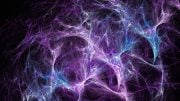
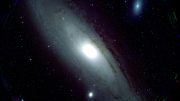
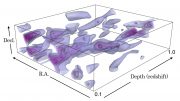
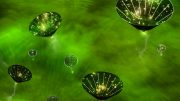
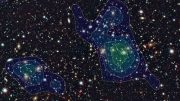


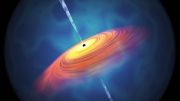
“there’s a discrepancy in the measurements that must mean that we got properties of the particle wrong”
Or, and hear me out, the particle just doesn’t exist. It’s not always a particle bro.
It is an observed gas.
There should be a rule against hinky dark matter maps that exclude all indications of luminous matter distribution within the same space. Maybe it would help explain why the clumps appear stretched out along the distance axis.
The stretched appearance along the depth axis implies the lensing model itself is biased and too fuzzy to distinguish between a galactic gravity well effect with or without a galactic scale concentric rippling.
They stretch cuz that’s how cosmic filaments work. This is no mystery. Stop trying to invent controversy, we have enough already.
Good for you, boy. You made up something imaginary and stupid to bother me, which is truly in the spirit of good solid Einstein worship, and now I’m going to ignore you.
No, it’s not arbitrary, but that isn’t the problem with your interpretation. Note that the declination and right ascension are celestial sphere coordinates while z is redshift. None of them are distances and there is nothing that says the model has corrected for that.
The luminous matter is just 20 % of all matter so including it won’t say much for the dark matter distribution. Nor will Einstein (?) since he is dead.
“Note that the declination and right ascension are celestial sphere coordinates while z is redshift. None of them are distances and there is nothing that says the model has corrected for that.”
You’re the only jackass suggesting declination and right ascension are distance dimensions.
Red flag 1 you emulate a robot, and keep pretending “Z” doesn’t map to distance, that’s red flag 2.
What happened to et al? Listing every name and first grade teacher might flourish in academic journals.
It’s et al. with dot and all, and it is not used for primary references but in main text.
Astrophysicists have never actually measured the Cosmic Microwave Background. That could be one reason for their discrepancies. And it seems they will never give up on the religious woo woo that brought us the “big bang”.
How can you claim something so profoundly stupid such as, “we’ve never measured the CMB, there so no big bang”? It’s so obviously true and has been recorded multiple times, I mean the original discovery was made almost with amateur equipment, that its nearly inconceivable to be that stuck in your ways. But that is the world we live in….
How can you claim something so profoundly stupid such as,” It’s so obviously true and has been recorded multiple times, I mean the original discovery was made almost with amateur equipment”? There are many reasons that measuring the CMB from satellites or rockets in near earth orbit can’t be done with todays technology. And the devices at L2 relied on earlier flawed data from these satellites and rockets or were differential instruments unable to measure anything except the temperature differences in small patches of the sky. It would be even more unlikely to get any real results with earth bound measuring devices, though the Orgov Radio-Optical Telescope in Armenia might be able to get good scientific observations. The CMB anisotropy maps have been hampered by the inability to remove the galactic foreground and the lack of knowledge of point source objects, things the map makers pretty much ignore. I could go on and on. Let me know if you can handle more “profoundly stupid” commentary.
CMB is measured with satellites for precision still today, but the original measurements was from ground. It is obviously a fact, and has been observed many times.
They literally made up CNB numbers so that it would work, changing values and deleting data points, and things like that until it looked the way that they wanted it to.
I don’t think it’s accurate and the sensitivity that they’re talking about that they would need to see this tiny discrepancy is ridiculous, so to make these huge estimations when at the same time they’re saying the sensitivity of the instruments is so high…
You literally made your claims up so your comment would seem to work. (It did not, since you have no factual claims.)
Since I’ve seen the cosmic background myself – it is 1 % of the noise in old tube television – I’m less impressed than usual with the fact denial (and superstition promotion in referencing religion).
The “clumps” aren’t clumps of Dark Matter, but of DUST and other particles that cause dimming in the Red Shift, altering their true distances and giving FALSE INFORMATION to these scientists that assume there’s nothing between us and the things we are measuring with it. This blatant (and obvious to anyone with a brain) error is the cause of distance and therefore size measurements that have lead to the purely mathematical INVENTION of so-called “Dark Energy” and “Dark Matter”.
There actually is no expansion of the Universe and therefore no Dark Energy. The real problem is we have humans that cannot admit they made a mistake almost a hundred years ago in making assumptions with Red Shift that clearly do not apply. There is cosmic dust and other crap between us and objects millions and billions of light-years away and is not evenly distributed so a simple math correction for “dust” cannot fix the errors. That is why other things being measured keep showing errors because Red Shift is not reliable for truly vast distances.
The dust “tired light” proposal was made as a hopeless one at the time.
” The concept was first proposed in 1929 by Fritz Zwicky, who suggested that if photons lost energy over time through collisions with other particles in a regular way, the more distant objects would appear redder than more nearby ones. Zwicky himself acknowledged that any sort of scattering of light would blur the images of distant objects more than what is seen.” [“Tired light”, Wikipedia.]
The current cosmology is fact based and works to explain those observed facts.
that “click to expand to full article” thing you’ve got going is really annoying.
Notice how no one is sure how long the latest 1A supernova is going to last?
Like “We expect the brightness to sort of hold steady for weeks, if not months” in one recent article.
Yet Shapiro et al. claimed to successfully use SN 1A duration as standard *duration* (not just brightness) candles.
This field is so doomed it’s insane
I’m the last one to claim that supernova ladder distances may be flawless. But what you note on individual supernovas isn’t relevant. About 30 % of supernovas has to be filtered out before they can be used in the well characterized ladder statistics.
The difference is still ~ 2 sigma, which is far from a 5 sigma observed tension, and I doubt it will grow further. It is hardly the “compelling inconsistency” as the teams claim.
One interesting thing with s_8 as opposed to Hubble rate tensions is that it is only weakly dependent on the cosmological ladder by way of photometric redshift uncertainties, and that the ladder then goes to higher z of 0.15 to 0.7 instead of the 0.005 < z < 0.05 where the supernova measurements pivot in order to mismatch the Planck observations. So it seems mostly a separate issue.
If only this changed anyone’s minds. Humans suck at that.